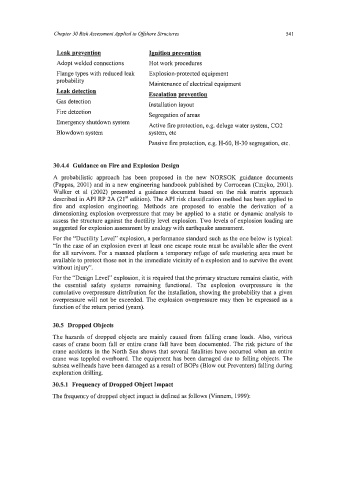Page 565 - Marine Structural Design
P. 565
Chapter 30 Risk Assessment Applied to offshore Structures 54 1
Leak prevention Imition prevention
Adopt welded connections Hot work procedures
Flange types with reduced leak Explosion-protected equipment
probability
Maintenance of electrical equipment
- -
Leak detection
Escalation mevention
Gas detection
Installation layout
Fire detection
Segregation of areas
Emergency system Active fire protection, e.g. deluge water system, C02
Blowdown system system, etc
Passive fire protection, e.g. H-60, H-30 segregation, etc.
30.4.4 Guidance on Fire and Explosion Design
A probabilistic approach has been proposed in the new NORSOK guidance documents
(Pappas, 2001) and in a new engineering handbook published by Corrocean (Czujko, 2001).
Walker et a1 (2002) presented a guidance document based on the risk matrix approach
described in API RP 2A (21st edition). The API risk classification method has been applied to
fire and explosion engineering. Methods are proposed to enable the derivation of a
dimensioning explosion overpressure that may be applied to a static or dynamic analysis to
assess the structure against the ductility level explosion. Two levels of explosion loading are
suggested for explosion assessment by analogy with earthquake assessment.
For the “Ductility Level” explosion, a performance standard such as the one below is typical:
“In the case of an explosion event at least one escape route must be available after the event
for all survivors. For a manned platform a temporary refuge of safe mustering area must be
available to protect those not in the immediate vicinity of n explosion and to survive the event
without injury?‘.
For the “Design Level” explosion, it is required that the primary structure remains elastic, with
the essential safety systems remaining fimctional. The explosion overpressure is the
cumulative overpressure distribution for the installation, showing the probability that a given
overpressure will not be exceeded. The explosion overpressure may then be expressed as a
function of the return period (years).
30.5 Dropped Objects
The hazards of dropped objects are mainly caused from falling crane loads. Also, various
cases of crane boom fall or entire crane fall have been documented. The risk picture of the
crane accidents in the North Sea shows that several fatalities have occurred when an entire
crane was toppled overboard. The equipment has been damaged due to falling objects. The
subsea wellheads have been damaged as a result of BOPS (Blow out Preventers) falling during
exploration drilling.
30.5.1 Frequency of Dropped Object Impact
The frequency of dropped object impact is defined as follows (Vinnem, 1999):

